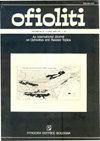Melt-rock interaction between granitic pegmatites and hosting amphibolites from the Chiavenna Ophiolitic Unit (Tanno Pegmatitic Field, Central Alps, North Italy)
IF 1.3
4区 地球科学
Q2 GEOLOGY
引用次数: 0
Abstract
The Tanno pegmatitic field, placed southward of Chiavenna (Central Alps, Sondrio, Italy), develops a large number of subplanar dykes that crosscut the Chiavenna Unit, an ophiolitic complex mainly composed, in the study area, of amphibolite rocks. This study focuses on the contact between a pegmatitic dyke and the amphibolitic country rock. We distinguished four zones across the contact: I) inner amphibolite, II) contact amphibolite, III) contact pegmatite, IV) inner pegmatite. The inner amphibolite, not affected by melt-rock interaction, is composed of amphibole, phlogopite, ilmenite, titanite and rutile. Two amphibole generations occur, both of them showing a patchy compositional zoning. Amphibole I are Mg-hornblende, whereas Amphibole II have a pargasitic composition. The contact amphibolite shows an enrichment of mica belonging to the phlogopite-biotite series, titanite and the presence of fluorapatite and plagioclase (Ab45-60), that is absent in the inner amphibolite. Close to the contact, amphiboles display no zoning and gain an Mg-horneblenditic composition. The contact pegmatite has quartz, albitic plagioclase, garnet (almandine-spessartine series), muscovite, K-feldspar and fluorapatite. It shows a comb texture, with elongation of plagioclase crystals normal to the contact itself. Far from the contact, the inner pegmatite has an increasing grain-size and a less organized texture. In this zone several accessory phases occur, including gahnite, columbite-(Fe), monazite-(Ce), xenotime-(Y), uraninite and betafite. Whole rock analyses suggest that a chemical exchange, concerning both major elements and trace elements, occurred between the pegmatitic melt and the hosting amphibolite. A considerable increase of SiO2, Na2O and, to a lesser extent, of Al2O3 is observed from the amphibolite towards the pegmatite; K2O and CaO show a decrease at the same extent. The REE pattern in the pegmatite highlights an enrichment in HREE at the contact. Mineral chemistry confirms this trend with variations observable in plagioclase, gradually more albitic from the amphibolite to the pegmatite. Mineralogical characters and geochemical features allow to classify the Tanno pegmatite in the LCT (Lithium, Cesium, Tantalium) family. Based on the metamorphic peak conditions reported from the Lepontine Dome the ambient conditions during pegmatite intrusion were ca. 550°C and 5 kbar. The reduced thermal difference between pegmatite and wall rock explains the diffuse contact observed by X-ray micro-computed tomography. The collected data suggest a chemical interaction between melt and wall rock, according to the following reaction taking place in the amphibolite Amphibole I + Amphibole II + Ilmenite + Pegmatitic melt → Amphibole III + Plagioclase + Phlogopite + Titanite + FluorapatiteChiavenna蛇绿岩单元(意大利北部阿尔卑斯山脉中部Tanno Pematitic油田)花岗伟晶岩和主控角闪岩之间的熔融岩相互作用
位于Chiavenna(意大利Sondrio的中阿尔卑斯山脉)南侧的Tanno伟晶岩田发育大量的亚平面岩脉,这些岩脉横切了Chiavenna单元,该单元是研究区内主要由角闪岩组成的蛇绿杂岩。本文研究的重点是伟晶岩岩脉与角闪岩的接触。我们划分出4个接触带:I)内角闪岩带,II)接触角闪岩带,III)接触伟晶岩带,IV)内伟晶岩带。内部角闪石不受熔岩相互作用的影响,由角闪洞、云母、钛铁矿、钛铁矿和金红石组成。发生了两代角闪洞,都显示出斑片状的成分分带。角闪孔I为镁角闪石,而角闪孔II为寄生成分。接触角闪岩富云母(属于辉云母-黑云母系列)和钛矿,并存在内部角闪岩不存在的氟磷灰石和斜长石(Ab45-60)。靠近接触面,角闪岩没有分带,具有镁角闪质成分。接触伟晶岩主要有石英、钠长石斜长石、石榴石(菱辉石系列)、白云母、钾长石和氟磷灰石。它呈梳状结构,斜长石晶体的伸长率与触点本身垂直。远离接触面,内部伟晶岩的晶粒尺寸逐渐增大,组织结构较松散。在这个带中有几个副相,包括辉长石、柱长石-(Fe)、独居石-(Ce)、钇矿-(Y)、铀矿和betafite。全岩分析表明,伟晶岩熔体与寄主角闪岩之间发生了主要元素和微量元素的化学交换。从角闪岩向伟晶岩方向,SiO2、Na2O显著增加,Al2O3增加较少;K2O和CaO的下降幅度相同。伟晶岩的稀土元素模式显示接触处稀土元素富集。矿物化学证实了这一趋势,在斜长石中观察到变化,从角闪岩到伟晶岩逐渐增加钠长石。其矿物学特征和地球化学特征可将坦诺伟晶岩归入LCT (Lithium, Cesium, Tantalium)科。根据利庞廷穹窿的变质峰条件,伟晶岩侵入时的环境条件约为550℃和5 kbar。伟晶岩和围岩之间热差的减小解释了x射线显微计算机断层扫描观察到的漫射接触。结果表明,在角闪石中,闪石ⅰ+闪石ⅱ+钛铁矿+伟晶岩熔体→闪石ⅲ+斜长石+辉云母+钛矿+氟磷灰石,熔体与围岩发生了化学相互作用
本文章由计算机程序翻译,如有差异,请以英文原文为准。
求助全文
约1分钟内获得全文
求助全文
来源期刊

Ofioliti
地学-地质学
CiteScore
2.40
自引率
7.70%
发文量
1
期刊介绍:
Since 1976, Ofioliti provides an international forum for original contributions and reviews in the field of the geodynamics, petrology, geochemistry, biostratigraphy, stratigraphy, tectonics and paleogeography applied to ophiolitic terrains and modern oceanic lithosphere, including their sedimentary cover. Studies of topics such as geodynamics of the mantle, the evolution of orogens including ophiolites and paleoceanography are also welcome
 求助内容:
求助内容: 应助结果提醒方式:
应助结果提醒方式:


